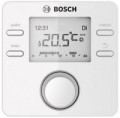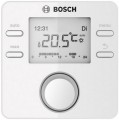Suitable for
The type of equipment for which the regulator is suitable.
Modern thermostats and automation systems can be used for:
- For different types of boilers —
gas,
electric,
solid fuel.
- For
heaters and underfloor heating - for both at the same time: the control features in both cases are very similar, which makes it easy to combine them in one device.
- For
pumps — namely for circulation pumps of heating systems.
— For
heat pumps. A heat pump provides heat transfer from the environment to the room, providing heating. (Air conditioners work on a similar principle, but their main task is cooling).
— For
fancoils. A fancoil is a device that cools or heats air by passing it through a system of pipes with a coolant circulating through them. And for the necessary heating or cooling of the coolant, another component of the system is responsible - a chiller, usually installed outdoors. A feature of such climate systems is that most of them can be used not only for heating in the cold season but also for cooling in the hot season.
— For
outdoor system. Regulators for various climatic equipment installed outdoors. These can be, for example, anti-icing systems, devices f
...or heating pipelines, chillers for chiller-fan coil systems, etc.
In many models, several options are combined at once; for example, most devices for electric boilers are quite compatible with gas boilers.
In any case, it is the first criterion that one should pay attention to when choosing.Control bus
The control bus for which the controller is designed.
The control bus can be described as a channel through which thermostats and controlled devices exchange signals. Often such a channel allows you to combine a fairly extensive set of equipment into one system. From a practical point of view, the meaning of this parameter is as follows: for normal operation, the thermostat must use the same bus as the boiler (or other controlled device), otherwise the interaction between them will be impossible. As for specific options,
eBus (used mainly by Protherm and Valiant),
OpenTherm,
EMS and EMS Plus, as well as
Bus BridgeNet(Ariston proprietary technology) have become widespread in climate technology. At the same time, among thermostats, you can find devices that support several options at once — usually EMS and OpenTherm. Also, note that the EMS and EMS Plus standards are not mutually compatible (with rare exceptions — such equipment is labelled "EMS / EMS plus").
Temp adjustment range
It is the range in which the air temperature can be set on the regulator. The choice for this indicator depends on the expected conditions in the room. So, in a residential building, the lower temperature limit at the level of 5–10 °C is quite sufficient; the upper limit is within 30–40 °C (regardless of whether we are talking about air or floor temperature). But in control devices designed for industrial use, this range will be much wider — from sub-zero temperatures to the upper limit of 100 – 125 °C.
Timer type
The type of timer provided in the design of the thermostat. In this case, a timer means a scheduler that allows you to programme different operating modes for different periods (for example, lower the temperature at night and increase it by the time you get up). Such schedulers are divided into types depending on the time covered.
—
Daily. The timer allowing to set the programme within 24 h; then the programme will be repeated every day. This variety is the simplest and, as a result, inexpensive. On the other hand, for most users, the daily routine on weekdays and weekends are noticeably different, and, most likely, the timer will have to be reprogrammed at least twice every week — before the weekend and at the end of the weekend.
—
Weekly. A timer that allows you to set a work programme for certain days of the week. The simplest varieties of such schedulers work according to the “5 + 2” scheme: one programme is set for 5 working days, the other for 2 days off. However, there are more advanced options — up to the ability to programme each day of the week separately. Anyway, weekly timers are more convenient and require less reprogramming than daily timers but they are much more expensive.
Minimum increment
The shortest duration a programmable thermostat cycle can have (see "Programmable cycles per day").
The lower this parameter (with the same number of cycles per day) — the wider the possibilities for programming the operation of the thermostat, in particular, for its specific setting (for example, you can provide a short period of preliminary "intensive heating" after working at low temperatures). On the other hand, due to a certain inertia in the operation of heating systems, it makes no sense to make an interval shorter than 10 minutes — the thermostat simply does not have time to work out the specified settings in less time. And in the most "long" models, this parameter is about 30 minutes.
Features
—
Display. The presence of its own screen in the design of the regulator. Such a screen is usually a simple LCD matrix with segment digits. However, even on such a screen, very diverse data can be displayed (including temperature with an accuracy of fractions of a degree), and this function significantly expands the capabilities of the thermostat and makes it more convenient. Note that it makes sense to install the display primarily in electronic models (see "Device type"), for such thermostats it is almost mandatory (but in mechanical ones, on the contrary, it is almost never used).
—
Protection of the pump from "souring". During non-working hours — for example, between heating seasons — deposits can form on the parts of the circulation pump of the heating system, which can make it difficult to rotate the impeller, reduce the efficiency of the pump, or even disable it altogether. This phenomenon is called "souring". To avoid it, automatic regulators may provide protection against acidification: periodically (once every few weeks) the pump is turned on for a short time, which prevents the formation of deposits (and removes those that have already formed).
—
Holiday function. A special regime provided for in case of a long absence of people in the house (for example, during a vacation — hence the name). In holiday mode, you can set a certain temperature to
...be maintained for several days (for example, a week; the maximum duration depends on the thermostat model). At the same time, in some models, this function is combined with frost protection (see below) and allows you to set only the minimum temperature (usually 5 °C); in others, the holiday temperature can be programmed.
— Random mode. A mode that provides for the inclusion of various heating functions in a random order (but without causing critical loads on the heating system). The most popular use of this feature is to simulate that someone is at home; this can stop intruders planning a theft in the absence of the owners.
— Management via the Internet. Ability to control the controller via the Internet. The device itself is usually connected to the network via Wi-Fi, and the control features may be different. For example, in some models you need to use a proprietary application installed on a smartphone or tablet, in others it is enough to open a special page in any browser. However, anyway, this function allows you to control the heating system remotely, from anywhere in the world. This can be extremely convenient in unforeseen situations — for example, if during the absence of the owner on the street it gets warmer. In addition, additional features such as advanced timer programming may be available with Internet control.
— Frost protection. A function that prevents freezing of the coolant in heating systems. Freezing water expands, which can lead to mechanical damage and depressurization of the system. To avoid this, regulators with this function are able to "monitor" that the temperature of the coolant does not fall below 5 °C, and, if necessary, turn on the heating to maintain the temperature. This function is relevant primarily for cases when the disconnected heating system must be left unattended for a long time during the cold season.
— Protection from children (blocking). The ability to lock the control panel of the regulator so that a curious little child cannot knock down its settings. The lock, usually, is turned on and off in such a way that an adult, but not a child, can easily do it — for example, by simultaneously pressing certain keys.
— Heater operating hours counter. Built-in counter that tracks the total heating time. This feature makes it much easier to keep track of the operating mode and heat costs, eliminating the need for the user to keep records manually and allowing you to track working hours even when there is no one nearby.
— Sensor calibration t. Possibility to calibrate the temperature sensor of the thermostat. In fact, situations may arise when the readings of the temperature sensor for one reason or another differ from the actual temperature in the room — for example, the controller is installed near an electrical appliance that generates heat and knocks down the setting, and neither device can be moved. For such cases, calibration is provided — an amendment to the readings of the temperature sensor. For example, if the thermometer in the middle of the room reads 20°C and the regulator's sensor reads 22°C, you can correct the thermostat to -2°C and the temperature displayed on the regulator will correspond to the true temperature. Of course, the correction can also be taken "in the mind" without reconfiguring the device; however, most often it is easier to set the necessary parameters in advance and not get confused in the calculations.
